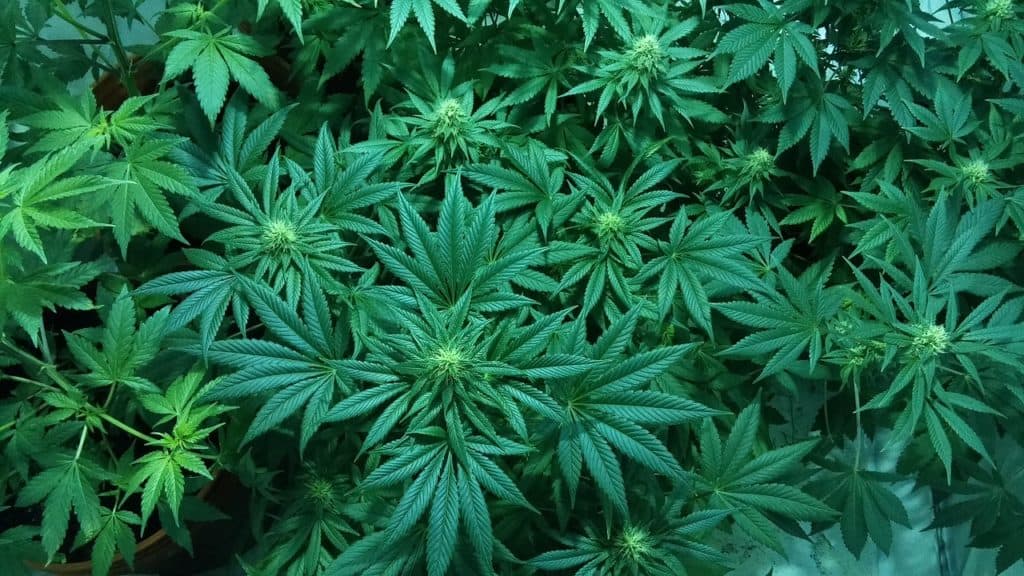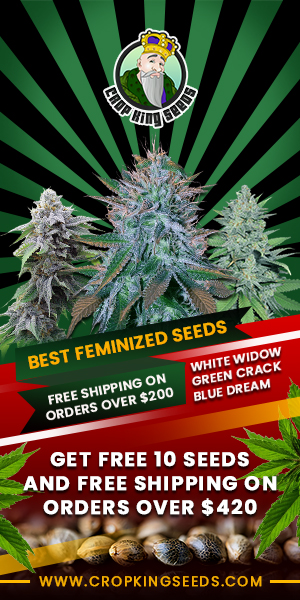Best Marijuana to Grow Indoors for Beginners – A Guide
Here You Will Find Everything You’ll Need To Know To Get You Started!
Get your green thumb out! At a high level this mini marijuana growing guide will teach you practically everything you need to know to start growing indoors, growing in a small space, and getting started as a beginner! Included is information for choosing the best strain for your particular situation, which light sources, which heat and setup you should be using, effective watering and feeding techniques, and of course, cultivation and harvest.

What are the Best Strains to Grow for Beginners?
Is it Sativa, Indica or Maybe a Hybrid?
The first thing you need to know is which plant works best for your current situation – which strain is the best to grow indoors for beginners? Which is the easiest strain to grow? Which are the best seeds to grow indoors? These are all questions that beg to be answered and there’s a lot of vague information out there!
Each different strain has different terpene content, THC & CBD amounts, scent, grow time, size and so forth. Choosing which one before you get started is a huge factor as to how it’ll all pan out. Growing a Sativa in a small room isn’t nearly as recommended compared to other strains, while Indicas are not ideal if you’re trying to grow a strain which won’t tire you out so much. While trying to be discreet, a low odor plant is definitely a necessity as well. Read on to discover which strain you should grow!
Indica Marijuana Strains
In general, the Indica species is the best to grow for beginners. Indica strains often have heavier, sleepier, more relaxed effects. These are best consumed during the night before sleeping or for a quiet evening watching TV. Indica plants typically feature:
Shorter flowering times: From start to finish, Indica plants often grow quicker than the others, leading to more frequent yields and ready to consume bud much quicker. If you mess up at some stage in the growth, restarting again is not as much of a setback as the others.
Small, bushy plants: This is certainly ideal for those looking to grow in a small, confined space. If the area which you’ll be sprouting your plants in is smaller than you’d like, do yourself a favor and definitely opt for an Indica-based seed.
Higher yields: In general, Indicas have the highest yield of all, especially with their shorter grow time and compact size. Between those three factors, Indica plants are often the most sought out by beginners.
Sativa Marijuana Strains
Sativa plants are still fantastic and my personal preferred type to consume due to the effects when consumed; they offer a brighter, clearer, lighter type of high, and are better suited to daytime consumption or sparking creativity. With that being said Sativas are oftentimes less frequently grown due to some factors such as:
Longer flowering times: While Indicas typically grow much quicker, Sativa plants frequently take longer to go from seed to bud, and if a mistake is made during the growing cycle by an amateur, it’ll take even longer to get back to where you were.
Tall and skinny plant: For the vertically challenged grow space, Sativa’s are a great selection if you have a lot of vertical space. You can often bunch up plenty of Sativa plants to create a mini-forest compared to a mini-jungle which Indicas produce. Important to keep in mind is that fluorescent bulbs don’t work quite as well with Sativas as the light doesn’t penetrate deep enough.
Lower yields: As a result from their longer grow time and lanky/sparse nature, Sativas aren’t as dense in bud when completely flowered, and thus produce lower yields as a result. For some people such as myself, this isn’t much of a tragedy, however if your consumption is particularly high, that may be detrimental for you.
Hybrid Marijuana Strains
As the name suggests, hybrid strains contain genes from the two above species, and as such there is a lot larger variety in their specific traits. Some hybrid strains are 80% Sativa, and 20% Indica, while some can be equally split at 50/50 and have equal traits from each parent strain. Each hybrid carries drastically different characteristic, so I’d recommend doing plenty of research before going for one.
My Choices for the Best Beginner Strains
Listed below are some of the best strains for beginners. If you’re trying to find a low-odor Sativa, a high yield Indica or find the easiest hybrid strain to grow, then check out the below list which has 9 of the most common and popular strains!
Regardless of which strain you end up selecting do yourself a favor and make sure the seeds are auto-flowering. Auto-flowering seeds and then plants will automatically start to flower (grow buds) after growing for a certain amount of time. This takes the guesswork out of trying to get your plants to start flowering yourself.
My Pick for Indica Strains
Easy to grow: Northern Light: A mere 8 weeks growth time, rather resilient and hugely popular around the world, Northern Light is one of the most commonly grown strains period. You definitely could not go wrong with Northern Light as a choice.
High yield: Super Skunk: One of the highest yielding Indicas with a THC concentration of around 16%, many medical patients and beginner growers love to use super skunk!
Low odor: Blue Mystic: A phenomenal beginners choice with low to virtually no scent to speak of as well as an amazing flavor to go along with it.
My Pick for Sativa Strains
Easy to grow: Green Crack: Hugely popular with a bright flavor, straightforward growth
High yield: Super Silver Haze: One of the most popular in the world, Super Silver Haze is a fantastic choice that both beginners and experienced growers love to use!
Low odor: Kali mist: A great, lightweight, and energizing strain for daytime use! Odor remains low and gives for a great product! Also has a delicious flavor!
My Pick for Hybrid Marijuana Strains
Easy to grow: Blue dream: A very easy to grow strain which produces great yields! Impressively resilient to fungal diseases and root rot too, ideal for avoiding first-timer mistakes. It also gives a perfect blend of Sativa and Indica based effects for general usage.
High yield: Sour diesel: A longtime favorite of many with a unique flavor profile, sour diesel offers very large yields and a high THC content of around 18%. Super dense plant which practically overflows with bud, sour diesel is a great high-yield choice
Low odor: African Free: A very high yielding, fruity smelling hybrid. Sativa dominant at 75%, African Free has delightful flavor, effects and has a very mild odor to it!
Marijuana Light Sources, Heating and Room Setup.
What’s the best light source for growing?
In all likelihood, you’re likely not using sunlight as a primary source of energy for your plants if you are growing indoors. There are three main options of light to choose from. Your results will vary drastically depending on which light source you choose, so ensuring you’ve picked the correct light source for your setup is instrumental to healthy, happy plants! The three most common grow lights are:
Fluorescent Bulbs for Your Grow Room
Fluorescent bulbs are very easy to find. Typically any home and hardware store will offer your typical ‘twisty’ CFL bulb. They provide a high spectrum of light, and work best when they’re in close proximity to your plants. A great combination with short and dense Indica plants if you’re limited in terms of space. You could also opt for the longer tube ‘T5’ fluorescent bulbs as well for larger setups!
As fluorescent bulbs are cheap, efficient, and produce very little heat, meaning you won’t need a heavy-duty ventilation systems that HID bulbs do. With that being said, fluorescent bulbs don’t work best for taller plants as the light doesn’t penetrate far enough. In general as well, fluorescent bulbs generate smaller yields in the end product – something to keep in mind if you’re looking to get the most bud per square meter!
Light Emitting Diodes (LEDs) for Your Grow Room
LEDs have been rising in popularity quickly. They often run quite cool, have great penetration which allows them to be setup much easier than fluorescent bulbs, and do not require extensive heat ventilation or reflective hoods to go along with them. LED setups tend to also be quite small as well, and once they’re setup they’re completely ready to go!
With that being said, LED setups perform much better when hung further away from the plants and for that reason, is not ideal for a compact setup. For the power consumption, yield/watt is slightly lower than HID bulbs, however only slightly so. LED setups are relatively inexpensive however not as cheap as fluorescent bulbs.
High intensity discharge (HID) bulbs for Your Grow Room
HID bulbs are much more efficient than fluorescent bulbs however they get extremely hot and heat ventilation is a factor that needs to be taken into consideration. Oftentimes HIDs are connected to a set of reflective hoods in order to radiate more light down onto the plants.
There are different varieties of HID bulbs as well, such as Light Emitting Ceramic (LEC), Metal Halide (MH) and High Pressure Sodium (HPS). Each type of bulb gives individual benefits at different stages of growth. MH bulbs are best suited for vegetative state while HPS bulbs excel at the flowering stage as bud production becomes stimulated.
As they are, HID lights are the most efficient as they produce the highest yield/watt, however they also produce high levels of heat which requires ventilation. While they’re relatively simple to use once setup, the extra gear such as a full heat ventilation setup and reflective hoods may not be ideal when trying to grow indoors in a small space.
Heating and Grow Room Setup
If you’re using a large amount of fluorescent or HID bulbs, heat dissipation will be essential. Over-heating your plants or worse – having them catch fire, is the easiest way to ruin a month’s worth of growth. Oftentimes, small-scale fluorescent or LED setups do not require any heat dissipation at all however effective ventilation is still necessary.
A solid inline-fan or two for small-medium setups, or a simple rotary fan for a small room will be effective for small setups, however for large-scale applications, industrial type solutions will work best. For a small-medium setup between 4-12 plants, a single in line fan can make all the difference in the world when it comes to the success of your growing operation. A Ventech 6” inline fan is a great solution as well as many of the other choices available on Amazon.
With ventilation comes carbon filters – they’re necessary for reducing scent or practically completely eliminating it. Ensuring you have a strong enough intake fan which creates a vacuum within your grow space will completely eliminate odor, provided the carbon filter is effective.
For smaller, tent-sized setups, lining it with a reflective surface even as simple as aluminum foil will benefit your plants greatly. Many grow tents feature a reflective surface already, however if you’re on a budget or more of a DIY-type person, lining the walls with aluminum foil, flat white reflective paint (not glossy) or a specially-made reflective film will drastically improve your harvesting results!
How Do I Water and Feed my Marijuana Plants?
Watering your plants is obviously crucial and important. Ensuring you follow proper watering techniques is also an important factor to take into consideration. While under-watering is important to avoid, over-watering is just as bad for them! If you’ve begun to notice wilting, darkening or loss of color, it could be a fault with watering or nutrition!
When Do I Water my Marijuana Plants?
When the top of your soil has become dry an inch deep (around the first knuckle), it’s time to water – at which point add water until around 10% or so of the amount water drains to the bottom of your pot. If it takes too long for your water to come out or your soil is still wet after 5-6 days, you may in fact have a drainage problem.
How to feed Your Plants
If you’re using a soil without fertilizer, it’s a good idea to add some sort of nutrients to your water. Every other watering, add a formulated mix like one made for apples or tomatoes, as it’ll certainly help your plants grow! If you’re using a soil which already has nutrients in it, do ignore the 10% water runoff rule as you don’t want to wash away any of the nutrients already in the soil! This is a high level intro to feeding your plants, there is definitely more to cover in another article.
Curing and Preparing the End Product.
If you’ve followed all aforementioned steps, you should be anywhere from 6-14 weeks in, depending on your strain and growing methods. You can tell when your plants are ready when they’re covered in trichomes and have a nice odor to them. There will be some white long hairs growing from the blooming buds, these are called pistils. They come and go throughout the entire growing phase and even towards the end of a grow cycle some new ones will keep forming.
Once between 60-75% of the pistils have darkened, it’s a good time to cultivate! Doing so at this time in the growing process will leave your buds with more THC in them, while allowing 70-90% of the hairs to darken leaves with you more CBN in the bud, which is responsible for being the relaxing, calming and pain-relief parts of the plant.
You can also use a magnifying glass or jeweler’s loupe to more accurately decipher when the best time to harvest is. There are different stages in the Trichome life cycle. Once the bulk of the tiny white ‘hairs’ have turned slightly cloudy, that’s the ideal time to reap your rewards!
Curing is the last and arguably most important step to the process! Improperly curing your buds, storing it wrong, or worst, letting mold accumulate can affect the flavor, smell, potency and overall quality of your cannabis! The best simple way to do this is follow the below steps:
- Manicure your buds from the stems and leaves
- Set them to dry in a dark room with humidity around 40-60% and at 60-70°F.
- Once the buds have become slightly ‘crunchy’ on the outside, move them into a ceramic, glass or metal jar.
- Seal the lids and move them to another cool, dry, dark place. A few times a day, open the jar temporarily to allow the oxygen inside to replenish and moisture to escape.
- Repeat step four for 1 week, and after the first week you’ll only need to open your container every other day or so.
- Depending on the strain you could be finished from 2-8 weeks, and some strains even like a long cure time of up to half a year.
Enjoy your end product at this point and repeat as necessary. Once you complete your first grow, every subsequent one becomes much easier and quite rewarding! Growing cannabis is an art, science, hobby and sometimes needs a little bit of luck on your side! Happy growing!
Related Growing Marijuana World Articles
Male vs Female Marijuana Plants How to Tell the Difference
What Size Pot is Best for Growing Weed?









